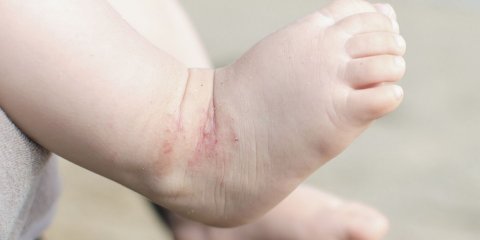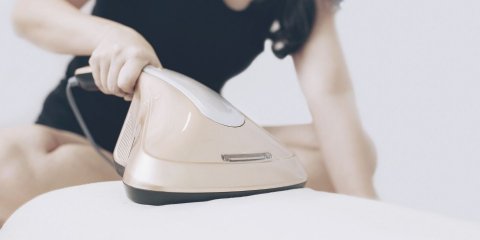Key Points
- Bedding can be a cause for skin irritation and skin allergies, especially in younger children with more sensitive skin.
- Natural fibers are the best choice for breathability, and Organic fabrics would ensure that far fewer toxins are present
- Make sure you wash new items before jumping in
Our kids’ beds should be safe spaces - providing comfort, quality rest and a place to bond over storytime. But for some, the choice of bedding can irritate and have an a detrimental to their health and wellbeing in particular to younger children.
In fact, because of the time children are exposed to bedsheets, pillows, and even the mattress, it plays a key role in causing or aggravating kids skin allergies.
Bedding made from organically grown materials , certainly helps, however, it may not be sufficient. Kids are more susceptible to skin irritations for a number of reasons:
- Size - their small size means they have a greater skin surface area than adults. That means they have more potential for absorbing toxic substances topically.
- Processing of Toxins - kids actually can’t remove chemicals from their bodies as well as adults can.
Consider for a moment how much time your kids spend directly in bed or cuddled up with their bedding. There's no doubt about it - it's a lot - infact kids spend around 40% of their time in their bed . Depending on what they are wearing, bedding also comes into contact with almost every part of their skin.

Team these factors with the fact that kids naturally have more sensitive skin than adults, and you can see the potential that kids bedding has for causing an allergic reaction on their skin. That’s why we can’t advocate enough how important it is to tread carefully when making your bedding choices.
So, what exactly is behind these allergic reactions?
- Eczema - triggered by a variety of things in the sleeping environment
- Dust mite allergies - triggered by dust mites taking up residence in the sleeping environment
- Pet dander allergies - triggered by dander in the sleeping environment
- Contact Dermatitis - Allergic contact dermatitis caused by laundry products
We’re going to explore each of these in relation to kids bedding and the steps you can take to remove or minimise the cause behind an allergic reaction on skin.
Eczema
Eczema (or atopic dermatitis) is an inflammatory skin condition of which at least 10% of children in the world have eczema and suffer from the characteristic symptoms of:
- Dryness
- Redness
- Itching
- Skin infections from scratching
In babies, these symptoms often manifest on the scalp, face and forehead first. In toddlers and older children, you’ll find the symptoms in the creases around the knees, elbows, ankles and wrists.

A host of factors can trigger eczema. In relation to kids bedding these include:
- Irritating fabrics
- Irritating soaps and detergents
- Overheating in bed
- Environmental allergies such as pet dander and dust mites
Eczema is an inflammation, so factors outside of simply the bedding need to be considered as well, such as diet. Certain foods can act as a trigger for Eczema and should be avoided:
- Cow’s Milk
- Eggs
- Soy Products
- Gluten
- Nuts
- Fish
- Shellfish
Foods high in amino acids (salmon, herring, and fish oil) and foods containing quercetin (apples, blueberries, cherries, broccoli and spinach) will help reduce the affects of eczema.
Itchy skin conditions like eczema tend to worsen at night thanks to the release of cortisol which contributes to skin inflammation . Continuous scratching or the effort of trying not to scratch can make a good night’s sleep difficult, if not impossible for your kids.
Broken sleep is not good for their development - it can affect learning, memory, immunity, mood and physical growth. While these factors can be challenging, if not impossible to control, there are things that you do have control over - like the environment your kids sleep in.
Dust mites allergies
Dust mites are so-named because of their habitat - household dust. They are difficult to see with the naked eye because they are less than half a millimetre in length. That means it can be hard to know how extensive your dust mite population is.
Dust mites love bedding because they prefer warm, moist environments. This makes pillows, mattresses and soft furnishings a haven for these tiny critters that eat flakes of our dead skin and mould.
Dust mite allergy can manifest as eczema, asthma and hay fever in your little ones. This isn’t because the dust mites bite, but the proteins contained within their bodies (including their faeces and other secretions) can trigger allergic symptoms.
Your aim should be to reduce the number of dust mites in your home (complete eradication is a bit too optimistic, unfortunately). You can do this by:
- Regularly cleaning your home and avoiding the build-up of clutter
- Vacuuming carpets weekly - preferably with a HEPA filter - or even better, remove carpets from your home
- Reducing humidity by using the exhaust fans in your bathrooms and kitchen
- Reducing humidity by keeping windows open whenever possible
- Avoiding putting throws over couches

While these measures aim at the prevention of dust mite build up, other more medical optional should be explored. Even adding probiotics into a child's diet may help bolster their immune system to help.
The use of probiotics in the treatment of allergic diseases is very promising, thanks to increasing evidence of their immunomodulatory effectsUS National Library of Medicine
While these are good practices to follow throughout the home for reducing dust mites and the associated allergic reactions on the skin, you should pay particular attention to your kids’ bedding. Do this by:
- Fitting the mattress with a dust mite cover to prevent them from making themselves at home
- Washing sheets, quilt covers and pillowcases weekly in hot water
- Washing all other bedding items every two months in hot water
- Removing all soft toys from the bedroom, or washing them weekly in eucalyptus oil.
- Vacuuming the seams of mattresses weekly
Pet dander allergies
Pet allergies aren’t necessarily triggered by the animal’s hair, but, rather, their dead skin flakes, known as dander. Allergic reactions on the skin caused by dander usually appear as:
- Puffy eyes
- Itching
- Irritated skin
- Runny nose
If you believe your child is suffering from a pet dander allergy, there are steps you can take to minimise their contact with the allergen. Those include:
- Making the bedroom a pet-free zone
- Never allow your pet to sleep on our child’s bed or bedding
- Vacuuming carpets regularly with a HEPA filter or even removing carpets entirely
- Choosing allergen-resistant bedding
- Washing bedding regularly
Laundry detergents and allergic reactions on the skin
What you wash your kids’ bedding in might be the cause behind allergic reactions on the skin. That can include laundry detergents, fabric softeners or stain removal products.
In fact, household chemicals are a common cause of allergic reactions on the skin. These often manifest as symptoms such as:
- Red and itchy skin
- Rashes to widespread or specific areas of the body, like the armpits, groin and face
- Skin tenderness or burning
- Skin swelling
- Dryness of the skin
A true allergy to these may not, in fact, cause redness or itching for a week, because the immune system can take time to detect allergens. Even when you’ve used them before, your kids can still have a reaction. That means it can take just a single or repeated exposure for allergic reactions on the skin to appear.
It’s often the chemicals involved in fragrancing or dying the detergents that cause the issue. But, it can also be the surfactants present in them to loosen dirt and oil particles. Even products marketed directly as baby detergents can contain these, so it’s important to know what to look for when choosing laundry products.
It’s all about making smart choices. That means looking for products which are:
- Dye-free
- Fragrance-free
- Hypoallergenic
And avoiding those with
- Preservatives
- Enzymes
- Optical brighteners
Opting for environmentally-friendly, plant-based detergents for your kids’ bedding can be a helpful way to prevent allergic reactions on the skin.
A few other tips:
- Double-rinse laundry to ensure there is no residue left from the detergent.
- Don’t use dryer sheets or fabric softener. Dryer balls made from wool, plastic or rubber can soften and reduce static without the irritants.
- Avoid chemical stain removers by pretreating stains naturally with a mixture of water and baking soda.
Can the type of bedding in your home help with sensitive skin?
We’ve mentioned that the bedroom environment, and particularly, kids bedding, can trigger or aggravate an allergic reaction on skin. We’ve created a guide below to help you make informed product choices to help minimise or eradicate those reactions.
Mattress
Coiled or innerspring mattresses are more subject to decay, mould and, you guessed it, dust mites. The metal coils tend to trap heat, and there is plenty of open air to allow dust mites to breed and thrive. That’s why natural latex or memory foam mattresses can make better alternatives for your kids’ beds. These types of mattresses are solid, which means there is nowhere for nasties like dust mites to hide out.
If you opt for memory foam, it’s wise to choose a mattress with a breathable cover to reduce the likelihood of overheating, which, as mentioned, is another contributing factor in triggering skin irritation.
Latex foam is naturally antibacterial and hypoallergenic. This environment is uninviting for bacteria or fungus, so you are less likely to see the growth of these. Latex has the benefit of being naturally temperature neutral.
Of course, latex will not make a suitable choice for children with latex allergies.
Pillows
Polyester and feather down retain more dust mites and are irritable to sensitive skin. In fact, 10% of the weight of a two-year-old pillow can be composed of dead mites and their droppings .
Natural wool and organic cotton, therefore, make the best alternatives. These types of pillows are naturally breathable and dry out dust mites. Top them off with 100% organic cotton pillow protectors that zip closed to act as a barrier to nasties and increase the life of your pillows as a bonus!
Quilts & blankets
Similar to pillows, you want to steer away from synthetic fibres and opt for natural fillings like wool, bamboo, silk or cotton. These help to wick away moisture.
If you need to add extra blankets during winter for warmth, it’s essential to choose ones that don’t have scratchy synthetic surfaces, nor are likely to cause overheating. Wool, bamboo, and cotton should be your go-to options. A good rule of thumb also is not to opt for the thickest blankets, but to add layers.
Choosing sheets, quilt covers and pillowcases
It’s no secret we’re big believers in using only organic bedding products. But, there’s more to this than just the “organic” label. When purchasing your bedding, it’s essential to look for the appropriate certifications to confirm that you are getting what has been promised.
GOTS (Global Organic Textile Standard) certification applies to all organic fibres which include cotton, wool, silk and bamboo. Although, for bamboo - please note that while it can be farmed organically in compliance with GOTS, the rayon process used to turn the bamboo into a usable material for textile processing voids the organic classification irrespective of the farming process.
GOTS certification means no chemicals, pesticides or harmful dyes were used during any stage of production and the product must also have been produced in line with strict waste management and water treatment requirements.
Oeko-Tex Standard 100 certification works to different levels of human-ecological requirements, based on the intended use of the products. The standard applies to any textile product and considers all forms of materials (i.e. raw, semi-finished and finished).
The more intensively a textile comes into contact with the skin (and the more sensitive the skin), the higher the human ecological requirements to be metSEC - Oeko-Tex Certification
It’s also a good idea to choose bedding sets that are free from embellishment. Although tassels and pom pom trims might look adorable, they can also be very irritating to your little one’s skin.
Washing sheets, quilt covers and pillowcases
Although you might be in a hurry to see how beautiful your new kids’ bedding looks in their room, the first rule of thumb is always to wash everything before use. Even when you’re investing in organic products, they have still passed through many hands before yours. That’s why you must be sure to wash all traces of germs before placing bedding in direct contact with your little ones.
In general, the weekly washing of sheets is enough to help reduce skin irritation, but for those with intense allergies, the daily changing of pillowcases can help significantly.
If you’d like more tips on washing organic cotton bedding, you can also check out our recent post.
Conclusion
So, when it comes to your kids and reducing the likelihood of allergic reactions on the skin, the key takeaways are:
- Wash bedding regularly in eco-friendly detergent that is free from dyes, fragrances and enzymes
- Make kids bedrooms pet-free zones
- Choose a mattress that doesn’t provide an inviting home to dust mites
- Buying GOTS-certified and Oeko-Tex certified organic cotton bedding protects your kids from toxins while giving them a breathable and non-irritating environment to sleep in
Most people choose kids bedding sets that are easy on the eye, but “easy on the skin” should be your motto if your child has sensitive skin. Luckily, Wriggly Toes provides the best of both worlds: gorgeous and fun designs with your kids’ wellbeing in mind.

